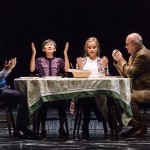“This Is What Happens When Obscurities Exist”
Reviewer: Cordelia Lee
Performance: 12 May 2019
Pangdemonium boldly brings to the fore the contentious subject of sexual misconduct in This Is What Happens To Pretty Girls. Its premiere is timely, given the recent spate of voyeurism cases and the prevalence of movements supporting the disclosure of sexual assault and trauma on social media.
Drawing upon interviews conducted with those who had previously been in such precarious situations, playwright Ken Kwek fleshes out eight characters interlinked in an intricate web of narratives: a student-professor relationship laced with romantic attraction goes wayward, a sexual encounter between colleagues is perceived very differently by each party, and an unearthed case of childhood sexual bullying haunts those involved.
Pangdemonium’s latest is breath of fresh air in a climate of technology-enhanced activism, where third-party bystanders swiftly dole out blame and impose victim/perpetrator binaries.
By sidestepping categorical pitfalls, the piece focuses on the grey areas inherent in some cases of sexual misconduct. It leverages on the liveness of the theatrical medium to do so, delivering a couple of uncomfortably visceral moments with sufficient nuance. This distinct quality of theatre privileges us, its spectators, as silent witnesses to the full unfolding sexual interactions within scenes. It renders us privy to details and nonverbal cues that even an articulate recount would fail to coherently capture.
A key example of this is when colleagues Natasha (Tess Pang) and Ray (Jamil Schulze) wind up at the latter’s apartment after a company party; what is meant to be a ‘couple of drinks’ gradually develops into a physically intimate encounter. Pang and Schulze put up a laudable attempt at portraying how wordless interactions can be easily misconstrued, if not missed altogether. They skilfully manoeuvre their bodies within the space in a passionate – albeit awkward – dance that is somewhat consensual, yet not quite. These shifting proxemics and body languages cause the concept of consent to remain in a flux throughout the scene.
Consent is never explicitly given or removed in speech. It instead ebbs and flows within the moments and spaces between the pair. Opportunities to decline sexual advances are sometimes taken, but at other times not. Communication is initiated when one notices the other’s discomfort, but disintegrates when the latter refuses to converse. It is here where the play makes its most salient point – witnessing all sides of a story unfold concurrently through an unbiased lens does not make it any easier to hold one party fully accountable for violated boundaries.
The multifaceted nature of the parties involved in each developing scenario is also explored. Confounding character traits and histories surface throughout the play, disrupting an easy mapping of stereotypes onto characters based on gender or powerplay within situations. Exposing a character’s inner vulnerability and desperation for clarity and repentance humanises them, without negating the severity of their offending action. Whereas stubborn, temporal silence can indicate a quiet resilience driven by sturdy rationale, and not entirely by weakness.
The strength in This Is What Happens To Pretty Girls is thus in its ability to offer us what the real world cannot – time and space to thoroughly review a matter through multiple lenses and perspectives, and the realisation that some cases of sexual misconduct and the labels we attach to those involved are perhaps more layered and complex than they may seem.
Do you have an opinion or comment about this post? Email us at info@centre42.sg.
ABOUT THE PRODUCTION
THIS IS WHAT HAPPENS TO PRETTY GIRLS by Pangdemonium
10 – 26 May 2019
Drama Centre Theatre
ABOUT THE REVIEWER
Cordelia is a BA (Hons) graduate from the National University of Singapore. She is interested in the work of emerging artists and community art groups, and hopes to draw greater public attention to the theatrical arts through her writing and participation in open dialogues.





